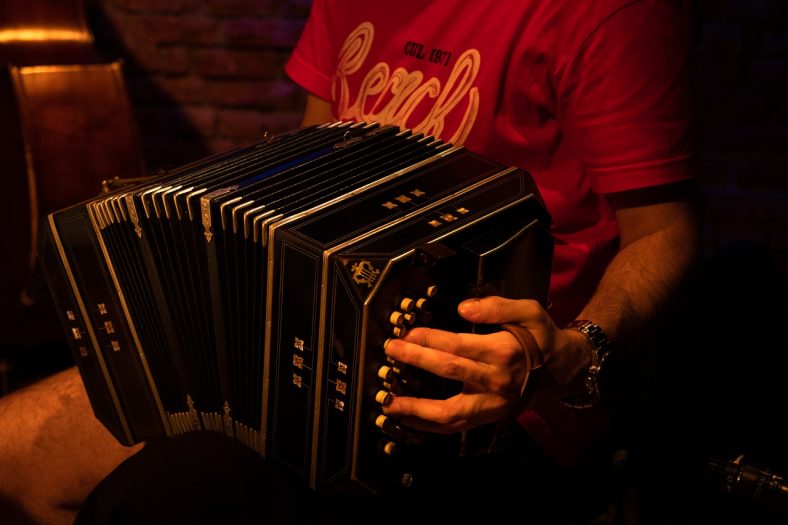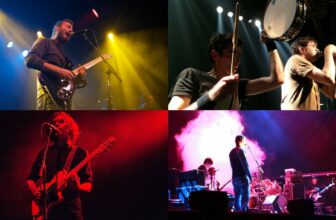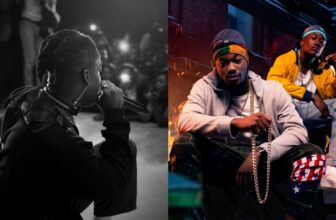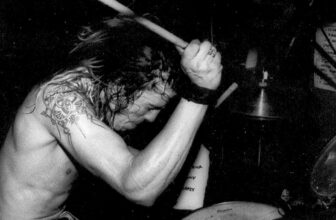What is Folk Music?

Folk Music is a broad music genre that can be divided into two major sub-genres: Traditional and Contemporary Folk. Traditional Folk is the music rooted in the oral traditions of a given social group. Contemporary Folk refers to a type of song-based American music derived from local folk traditions.
The term “Folk Music” is hard to define because it’s attributed to many different music genres. In a way, it’s almost as ambiguous as the concept of world music because it seems to ignore the drastic differences that exist between people, regions, and musical traditions all over the world.
Pretty much like “world music,” “Folk Music” is the name given to any form of music that originates from the people. This may include work songs, tribal hymns, religious anthems, and anything in between. It’s so vast that it encapsulates everything from Country Blues to the alien-like textures of Tuvan throat-singing.
With the popularization of the folk-inspired songs of artists such as Bob Dylan, Joni Mitchell, Joan Baez, or John Fahey in the 60s and 70s, musicologists started making a distinction between Traditional Folk Music (or the folk music I’ve referred to in the last paragraph) and Contemporary Folk (which is usually produced by singer-songwriters, mostly acoustic, and guitar-driven).
Contents
What is Traditional Folk Music?
At its core, Traditional Folk Music is mostly a workaday activity: the sounds people make when they are working, partying, praying, or signaling a certain rite of passage. It’s not a music genre per se, but rather a specific behavior towards music. In one word, it’s anthropological.
The sheer broadness of Traditional Folk Music makes it hard to categorize it, but it should be understood in opposition to pop and classical music. While pop music is “manufactured” with the intent to sell and classical music is “structured” with the intent to be preserved, Traditional Folk Music is merely the reflection of a given culture and passed on orally, not via an object (such as a vinyl record or a piece of sheet music).
In this video (which is worth a watch), the University of Liverpool professor of music Michael Spitzer argues that the figure of the composer only appeared very late in the history of music and that, for thousands of years, music was made by the people (i.e., by the anonymous collective) and used to accompany various day-to-day activities.
That’s why Traditional Folk Music is mostly anthropological: because it’s rooted in the traditions of a country, territory, or social group. Just like nobody knows who invented the customs of any of Uganda’s 40-plus indigenous tribes (for example), nobody knows who invented Indigenous American Music, Canadian Folk Music, or East Asian Music.
Can Traditional Folk Music be defined?
For all we know, Traditional Folk Music refers to all the distinctive genres of music that were produced by people, not by a modern-era composer. They’re drastically different from one another and include music from all over the world, but they all share a few traits.
So, how can we define a music genre as broad as Traditional Folk Music?
- Traditional Folk Music was not composed by one person or entity, but rather shared anonymously from generation to generation.
- Traditional Folk Music belongs to the oral era of music, before the invention of music notation and, once more, the proliferation of the composer.
- Traditional Folk Music is necessarily ancient or, at least, very old.
- Traditional Folk Music is based on specific cultures, meaning it derives from a certain class of people, country or territory, ethnic group, or historic period.
- Traditional Folk Music features traditional music instruments that, in many cases, are also typical of a specific culture.
What is Contemporary Folk?
Unlike Traditional Folk Music, Contemporary Folk isn’t anthropological, but rather historical. It’s possible to pinpoint the moment in time it first appeared and explore the decades during which it was most popular. While not all Contemporary Folk artists are based in the United States, the genre is viewed as being mostly American.
So, how did Contemporary Folk come into existence? The American singer-songwriter Woody Guthrie is often described as the pioneer of the genre. Guthrie inspired a generation of artists by revisiting the Traditional Folk Music songs of the South Central region of the United States and composing original songs in the same style.
By doing so, Guthrie combined two entirely different musical paradigms. On one hand, there was the anonymity of the Folk Music of South Central America, composed by “no one” and passed on orally from generation to generation. On the other, there was the authoritative figure of the composer, who performed, recorded, and released Folk-sounding songs under his name.
Like the wick of a candle, Guthrie was the flash that lighted the Contemporary Folk craze that hit the United States (and other Anglo-Saxonic nations) in the 60s and 70s.
A guitar and a poem: the fundamentals of Contemporary Folk
Contemporary Folk is a living music genre, contrary to Traditional Folk Music (which can be adapted to modern times but is fundamentally rooted in ancient local cultures). It’s often associated with the American folk revival of the 60s and 70s, during which artists such as Joan Baez and Bob Dylan followed the footsteps of Guthrie to come up with original, folk-based songs.
So, how do we define Contemporary Folk? These are some of the most distinctive elements of the genre:
- Contemporary Folk is song-based, meaning that it follows a standard song structure in which the lyrics play a prominent role.
- Contemporary Folk usually involves one or more acoustic instruments (most commonly, the acoustic guitar).
- Contemporary Folk includes elements of Traditional Folk Music, generally reflected in the singer’s vocal melody or the theme of the lyrics.
- Contemporary Folk is “new,” meaning it adds something original to the Traditional Folk Music songs it’s inspired by. Commonly, Contemporary Folk artists appropriate the old to state something new.
The most popular types of Folk Music
As seen, Folk Music can be divided into two major sub-genres. It would be impossible to list even a fraction of the genres of Traditional Folk Music that have been documented.
Brazilian Folk Music alone, for instance, includes sub-genres as disparate as the Aboio (cattle-herding songs from rural areas), the Jongo (percussive protest songs), the Sertanejo (guitar-driven songs from the ’20s), and the Capoeira (the music that accompanies the dance style of the same name).
However, it’s much easier to draw a picture of the influence and evolution of the Contemporary Folk revival based on a few key sub-genres. That said, these are the most popular types of Contemporary Folk music.
American Primitivism
A guitar-based genre, American Primitivism is defined as a combination of the playing techniques of Country Blues (a style of Traditional Folk Music) and the complex structures and arrangements of avant-garde classical music.
Unlike Contemporary Folk, American Primitivism is mainly instrumental and focuses on combining folk and erudite music rather than delivering a message. The guitarist John Fahey is widely regarded as both the pioneer and main exponent of the genre.
Neofolk
Neofolk emerged in the 80s and combined the song-based nature of Contemporary Folk with elements of Industrial, Dark Wave, and Dark Ambient. It’s different from Contemporary Folk not only because of its lyrical content (usually focused on themes such as nihilism and counterculture) but also because of its complex arrangements.
Some of the most famous Neofolk acts around include bands such as Current 93, ROME, and Death in June.
Indie Folk
Indie Rock was the sound of the 2000s, and it didn’t take long before musicians noticed that catchy Indie-Rock riffs and sweet Contemporary-Folk songs made for a best-selling match.
Indie Folk continues to be a popular genre today and is best represented by the likes of Bright Eyes, Elliott Smith, Fleet Foxes, Bon Iver, and Sufjan Stevens.
Freak Folk
Inspired by the “freaky” Contemporary Folk songs made by hippies in the 60s, artists from the New Weird America movement started incorporating the “silliness” of obscure Flower-Power acts into their modern compositions.
Freak Folk records are characterized by adopting the fundamental principles of Contemporary Folk while adding a disruptive element. Class Freak Folk acts include Devendra Banhart, Animal Collective, Vashti Bunyan, and Joanna Newsom.
Anti-Folk
Because Contemporary Folk tends to take itself too seriously, some folk artists from the early 2000s onwards started making songs that were all about breaking tradition, being casual, and exploring self-mocking themes.
If Contemporary Folk is all about delivering an important message, Anti-Folk is about the exact opposite. Top Anti-Folk artists include Andrew Jackson Jihad, Kimya Dawson, The Moldy Peaches, and Regina Spektor.
Conclusion
From Mexico’s Mariachi to Spain’s Flamenco, from Portugal’s Fado to Bluegrass: Folk Music is such a broad term that it can apply to music produced by pretty much all types of instruments in literally every corner of the Earth. So, does it even make sense to discuss it?
Well, there’s surely value in the notion of Folk Music in opposition to pop music and classical music. And, as professor Michael Spitzer has taught us, Traditional Folk Music remains our sole point of access to a period of music history in which the spectacle of show business, the stiffness of musical notation, and the egocentrism of the composer were still out of the picture.
In other words, Folk Music provides us a glimpse into the most authentic forms of music.





